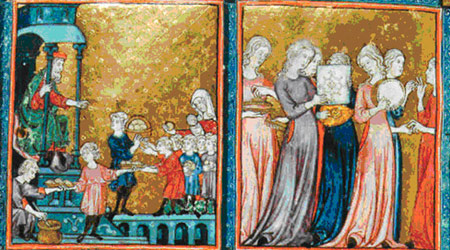The Locked-in Music

La Música Encerrada: The Spain of the three cultures from the XII – XVI Centuries.
During the Middle Ages in Europe, Spain became well-known for the coexistence of three religions and cultures: the native Christianism, Judaism, and the Muslim faiths; protected by the caliphs since the VIII century and up until the end of the XV century, they governed the Spain of today. The best thinkers, scientists, and artists of that time coexisted harmoniously in that Sefarad of the Three Cultures. In the XII century, anonymous poets of Castilla mimicked the French epic poetry and created the Mió Cid. Afterward, the lyrical chanting of the troubadour came from the south of France to Iberian lands and installed itself with the art called mester de juglaría; in opposition to erudite mester de clerecía. These were the times of The Crusades, such as that in the XIII century against the Albigensians, and which led the singer poets protected by Afonso X, the Wise One (who ruled between 1252 and 1281) and his son-in-law, don Dionís of Portugal to take refuge in Castilla. At the same time of the appearance of Castilian, emerged the first literature in other Iberian romance languages, such as the Gaelic-Portuguese and the Catalan.
Sephardi or Sephardic music was born from the Jewish Spaniards who were installed in Castilla and Aragón and adapted popular Castilian songs until their expulsion in the times of the Catholic Kings; becoming a fusion of Arab and Christian music. The songs were Arab in their rhythm and the instruments played, and Christian because they were sung in Castilian. The most recurrent theme of Sephardic songs is love, although one could also point out lullabies and wedding songs. For that matter, when speaking about Sephardic music one cannot refer to it as a new music genre, but rather as an adaptation of melodies that already existed, that were composed by the Jewish people arriving to Spain and of the rhythmical and instrumental richness that they won with the arrival of the Sephardim. After the Sephardim were expelled from Spain, they carried their musical traditions to Turkey, Greece, and Bulgaria; the countries were they primarily established. Despite the passing by of the centuries, they have been able to keep in Castilian the songs that they inherited from their Iberian ancestors, adding words from the vernacular. It is through the Sephardi music that continues to be played in the Oriental Mediterranean that today one can get an idea of how this music sounded in the Middle Ages.
This concert is made possible with the generous support of The Consulate General of Spain in New York, the Instituto Nacional de las Artes Escénicas y la Música (INAEM) of the Ministry of Culture of Spain, and the Institut Valencià de la Música of the Generalitat Valenciana. Special thanks to Lori Corsin, Mark Heutlinger, and Dr. Mark Weisstuch for their assistance to make this concert possible at the Temple Emanu-El.
- Music
- New York
- Oct 18, 2011
- 07:00 pm
Venue
Temple Emanu-El, 1 East 65th Street, New York, NY
View on Google Maps